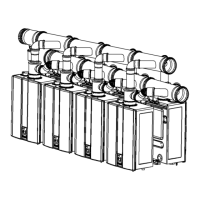4 Polypropylene (PP) Common Venng Installaon Instrucons
The Common Vent System provides longer vent lengths and fewer wall or roof penetraons than convenonal single-
unit venng.
Features include:
• 3 in., 4 in. and 6 in. common vent PPTL common vent components are approved for use in the U.S. only and not
available for installaons in Canada.
• Canadian common vent installaons must use 6 in. PPS (gray) common vent components.
• Cered to ANSI Z21.10.3 - CSA 4.3 for U.S. and Canadian installaons.
• Venng material is comprised of Polypropylene (PP). For the exhaust ue, U.S. installaons ulize PPTL — a CSA-
cered and tested venng material. Canadian installaons ulize PPS, a ULC-S636-cered and tested venng
material from Ubbink.
• The various secons are self locking and sealing and can be pushed together without use of cement or glue.
Do Not
• Do not exceed the maximum number of units indicated
in the Rinnai Tankless Water Heater Installaon and
Operaon Manual.
• Do not use cellular core PVC/CPVC, Radel, ABS or
galvanized material for the exhaust vent.
• Do not combine vent components from dierent
manufacturers.
• Do not connect the venng system with an exisng
vent or chimney.
• Do not cover vent components with thermal insulaon.
• Do not common vent with the vent pipe of any other
type of water heater or appliance.
• Do not reduce vent diameter to less than 2 in.
• Do not install the water heater in an area of negave
pressure.
• Do not install the water heater, venng, and vent
terminaon(s) in any areas where the air may contain
corrosive compounds.
Must Do
• You must use vent components that are cered
and listed with the water heater model.
• The vent system must vent directly to the outside
of the building and use outside air or room air for
combuson.
• Avoid dips or sags in horizontal vent runs by
installing supports per the vent manufacturer’s
instrucons.
• Support horizontal vent runs a minimum of every
four feet and all vercal vent runs a minimum of
every six feet.
• Venng should be as direct as possible with a
minimum number of pipe ngs.
• Vent connecons must be rmly pressed together
so that the gaskets form an air ght seal.
• Vent components connected to the water heater
must be secured with one self-tapping screw. Do
not use any glues or solvents to connect vent
components to the water heater.
• Set the temperature seng on all water heaters
being common vented to the same temperature.
Exhaust components must be propylene (PP/PPTL) for U.S. installaons and PPS for Canadian installaons. All venng
components used in Canada must be ULC-S636 cered. Intake components to be in accordance with naonal and/or
local codes having jurisdicon.
WARNING

